| Area |
Caspar Creek |
| Topic |
Tour: Caspar Creek 1995 Stream Photos Mainstem & NF |
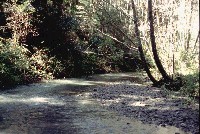 Click on image to enlarge (143K). Click here to display a larger version (351K).
Click on image to enlarge (143K). Click here to display a larger version (351K).This photo is of the mainstem Caspar Creek less than one mile downstream of the convergence of the North Fork and South Fork. The shade canopy here is thick and the substrate of the stream bed coarse. Photo taken looking upstream. February 1995. Photo by Pat Higgins.
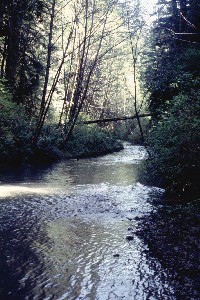 Click on image to enlarge (148K). Click here to display a larger version (362K).
Click on image to enlarge (148K). Click here to display a larger version (362K).Caspar Creek downstream of the North Fork and South Fork convergence. Canopy for the creek is provided mostly by alders and small conifers. Overhanging vegetation provides good cover for rearing salmonid juveniles. February 1995. Photo by Pat Higgins
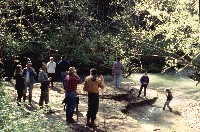 Click on image to enlarge (158K). Click here to display a larger version (401K).
Click on image to enlarge (158K). Click here to display a larger version (401K).North Fork Caspar Creek flows left to right in the photo with the South Fork joining it at far right. The sediment terrace is of fine material and would be subject to transport in high flows; therefore, it is likely that it was recently deposited. Side channel of mainstem Caspar Creek cuts through the fine material of the terrace where young boy wades. February 1995. Photo by Pat Higgins
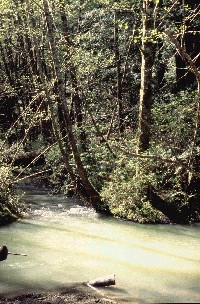 Click on image to enlarge (148K). Click here to display a larger version (416K).
Click on image to enlarge (148K). Click here to display a larger version (416K).South Fork Caspar Creek joins North Fork. Canopy provided by alders and young conifers. Over-hanging alders and shrubs improve habitat complexity for salmonid juveniles and provide food in the form of terrestrial insects, which may fall off them. Note that the water is somewhat turbid as a result of fine sediment in transport. February 1995. Photo by Pat Higgins
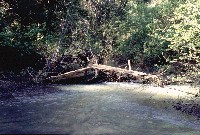 Click on image to enlarge (146K). Click here to display a larger version (359K).
Click on image to enlarge (146K). Click here to display a larger version (359K).Large woody debris on Caspar Creek downstream of convergence forms a pool which measured less just over a meter in depth. Depth was restricted because of the amount of sediment in transport. February 1995. Photo by Pat Higgins.
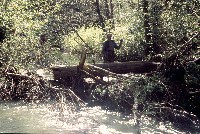 Click on image to enlarge (134K). Click here to display a larger version (443K).
Click on image to enlarge (134K). Click here to display a larger version (443K).Looking upstream at the same large wood jam as in Picture #5. Large woody debris formed pools, such as this one, are the preferred habitat of coho salmon juveniles. February 1995. Photo by Pat Higgins
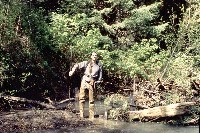 Click on image to enlarge (153K). Click here to display a larger version (416K).
Click on image to enlarge (153K). Click here to display a larger version (416K).Tom Fiore holds V-Star rod indicating that the sediment deposition adjacent to the large wood jam is over a meter deep. This material has a very small particle size distribution and is likely to be remobilized by even moderate storm events. February 1995. Photo by Pat Higgins
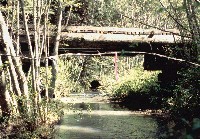 Click on image to enlarge (92K). Click here to display a larger version (403K).
Click on image to enlarge (92K). Click here to display a larger version (403K).This photo was taken looking up the North Fork Caspar Creek from the convergence. Photo by Pat Higgins. February 1995.
 Click on image to enlarge (143K). Click here to display a larger version (351K).
Click on image to enlarge (143K). Click here to display a larger version (351K). Click on image to enlarge (148K). Click here to display a larger version (362K).
Click on image to enlarge (148K). Click here to display a larger version (362K). Click on image to enlarge (158K). Click here to display a larger version (401K).
Click on image to enlarge (158K). Click here to display a larger version (401K). Click on image to enlarge (148K). Click here to display a larger version (416K).
Click on image to enlarge (148K). Click here to display a larger version (416K). Click on image to enlarge (146K). Click here to display a larger version (359K).
Click on image to enlarge (146K). Click here to display a larger version (359K). Click on image to enlarge (134K). Click here to display a larger version (443K).
Click on image to enlarge (134K). Click here to display a larger version (443K). Click on image to enlarge (153K). Click here to display a larger version (416K).
Click on image to enlarge (153K). Click here to display a larger version (416K). Click on image to enlarge (92K). Click here to display a larger version (403K).
Click on image to enlarge (92K). Click here to display a larger version (403K).